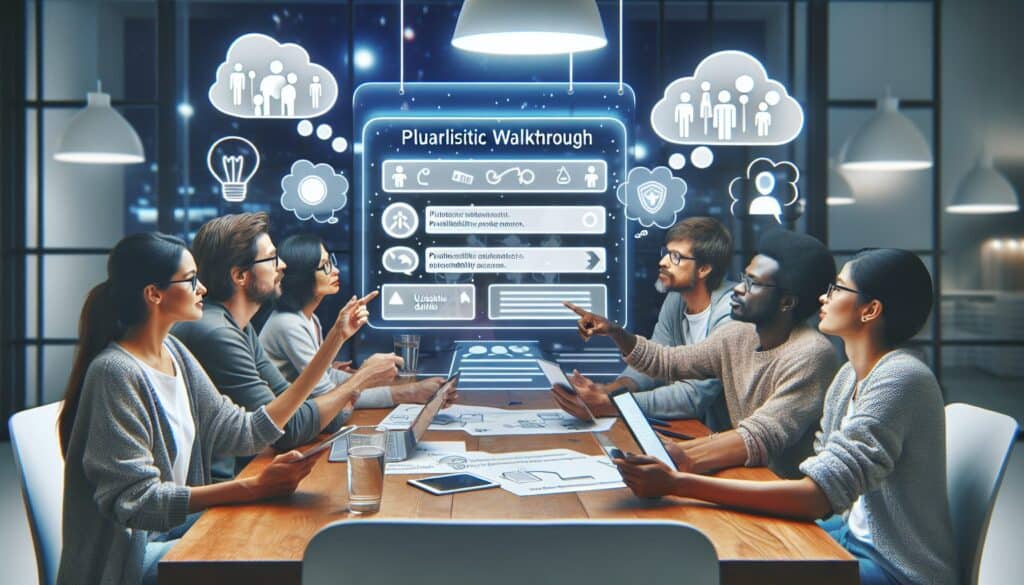Eine Methode zur Überprüfung der Benutzerfreundlichkeit, bei der eine Gruppe von Benutzern, Entwicklern und Usability-Experten gemeinsam ein Aufgabenszenario durchgehen und bei jedem Schritt Usability-Probleme besprechen.
- Methodologien: Maschinenbau, Qualität
Pluralistische Komplettlösung

Pluralistische Komplettlösung
- Bewertung des Designs, Design Denken, Human-Centered Design, Interaktionsdesign, Benutzerfreundlichkeit, Benutzererfahrung (UX), Benutzeroberfläche (UI), Benutzer-Tests, Benutzerzentriertes Design
Zielsetzung:
Wie es verwendet wird:
- Die Gruppe arbeitet zusammen, um potenzielle Probleme aus verschiedenen Blickwinkeln zu identifizieren, das Nutzererlebnis zu simulieren und die Designelemente und den Ablauf zu kommentieren.
Vorteile
- Bringt verschiedene Perspektiven in die Evaluierung ein; kann ein breiteres Spektrum an Usability-Problemen identifizieren; fördert das gemeinsame Verständnis und die Zustimmung zu Designänderungen.
Nachteile
- Die Organisation und Durchführung kann zeitaufwändig sein; es bedarf eines geschickten Moderators, um die Gruppendynamik zu steuern und die Sitzung fokussiert zu halten; Gruppendenken kann ein potenzielles Problem sein, wenn es nicht gesteuert wird.
Kategorien:
- Produktdesign, Qualität
Am besten geeignet für:
- Bewertung der Benutzerfreundlichkeit eines Systems, indem eine Gruppe von Benutzern, Entwicklern und Usability-Experten gemeinsam Aufgabenszenarien durchgehen.
In the realm of product design and development, the Pluralistic Walkthrough is particularly beneficial during the early phases of a project, such as conceptualization and initial design, where user involvement is pivotal for ensuring usability. This methodology is frequently adopted in various sectors including software design, web application development, and consumer electronics, where user interface and interaction are paramount. During these collaborative sessions, participants typically include end-users who represent different demographics, designers, developers, and usability specialists, who collectively contribute their thoughts as they step through task scenarios, mimicking the user’s experience with the system. The involvement of diverse stakeholders not only enriches the evaluation with multifaceted feedback but also turbocharges team cohesion and understanding of user needs. For instance, in a project aimed at creating an educational app, educators, students, and designers might engage in a Pluralistic Walkthrough to identify pain points from all angles, such as navigation difficulties or content accessibility. This approach enables teams to capture a broader range of usability concerns and promotes a shared commitment to the design revisions, laying a foundation for nutzerzentriert iterations that can ultimately lead to more effective and engaging products. Additionally, employing this methodology can yield data that is invaluable for subsequent stages of a project, such as development or closer usability testing, ensuring a smoother transition from design to implementation.
Die wichtigsten Schritte dieser Methodik
- Define task scenarios relevant to the system being evaluated.
- Participants individually review the scenarios to note potential usability issues.
- Conduct a group discussion where each participant shares their observations.
- Simulate the user experience step-by-step for each task scenario.
- Encourage diverse viewpoints to examine design elements and workflows.
- Identify and document usability problems as a collective.
- Discuss possible design solutions or modifications based on the findings.
Profi-Tipps
- Encourage participants to articulate their assumptions and expectations during the walkthrough to uncover unspoken Vorurteile and preconceptions.
- Utilize a clear and structured scenario framework to guide discussions, ensuring all aspects of the user experience are systematically evaluated.
- Record the insights and feedback in real-time, categorizing them by severity and frequency to prioritize design changes effectively.
Verschiedene Methoden lesen und vergleichen, Wir empfehlen die
> Umfassendes Methoden-Repository <
zusammen mit den über 400 anderen Methoden.
Ihre Kommentare zu dieser Methodik oder zusätzliche Informationen sind willkommen auf der Kommentarbereich unten ↓ , sowie alle ingenieursbezogenen Ideen oder Links.
Historischer Kontext
1986
(wenn das Datum nicht bekannt oder nicht relevant ist, z. B. "Strömungsmechanik", wird eine gerundete Schätzung des bemerkenswerten Erscheinens angegeben)

Verwandte Artikel
Master Production Schedule (MPS)
Massenanpassung
Marketing-Trichter
Marketing-Audit
MAPO-Index (Bewegung und Unterstützung von Krankenhauspatienten)
Fertigungsressourcenplanung (MRP II)